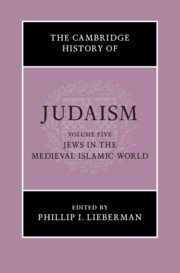Book contents
- The Cambridge History of Judaism
- The Cambridge History of Judaism
- The Cambridge History of Judaism
- Copyright page
- Contents
- Figures
- Acknowledgments
- Introduction
- Part I Jews in the Medieval Islamic World
- Part II Social and Institutional History
- Part III Spiritual and Intellectual History
- Chapter 17 Karaism
- Chapter 18 Non-Rabbinic and Non-Karaite Religious Movements
- Chapter 19 Languages and translation
- Chapter 20 Book Production
- Chapter 21 Jewish Bible Exegesis in Muslim Lands in the Middle Ages
- Chapter 22 Jewish Law
- Chapter 23 Liturgy
- Chapter 24 Piyyuṭ
- Chapter 25 Jewish Philosophy
- Chapter 26 Science and Medicine
- Chapter 27 Magic
- Chapter 28 Mysticism
- Chapter 29 Belles Lettres
- Chapter 30 Jewish-Muslim Polemics
- Chapter 31 Historiography
- Chapter 32 Material Culture, Art, and Architecture
- Index
- References
Chapter 18 - Non-Rabbinic and Non-Karaite Religious Movements
from Part III - Spiritual and Intellectual History
Published online by Cambridge University Press: 21 August 2021
- The Cambridge History of Judaism
- The Cambridge History of Judaism
- The Cambridge History of Judaism
- Copyright page
- Contents
- Figures
- Acknowledgments
- Introduction
- Part I Jews in the Medieval Islamic World
- Part II Social and Institutional History
- Part III Spiritual and Intellectual History
- Chapter 17 Karaism
- Chapter 18 Non-Rabbinic and Non-Karaite Religious Movements
- Chapter 19 Languages and translation
- Chapter 20 Book Production
- Chapter 21 Jewish Bible Exegesis in Muslim Lands in the Middle Ages
- Chapter 22 Jewish Law
- Chapter 23 Liturgy
- Chapter 24 Piyyuṭ
- Chapter 25 Jewish Philosophy
- Chapter 26 Science and Medicine
- Chapter 27 Magic
- Chapter 28 Mysticism
- Chapter 29 Belles Lettres
- Chapter 30 Jewish-Muslim Polemics
- Chapter 31 Historiography
- Chapter 32 Material Culture, Art, and Architecture
- Index
- References
Summary
The range of Jewish religious variety in medieval Islamic societies was shaped both by elements innate to Judaism and by the contemporaneous historical environment. Two perennial forces typically shaped modes of difference. Messianic and prophetic claims date back to at least the Hellenistic era, and coupled with apocalypticism promised Jews a final resolution to fundamental problems (in this period, specifically, the problems of Jewish powerlessness and dispersion). Older still was interpretive disagreement over matters of Scripture and law, based on the idea that Jews constitute a scriptural community whose covenantal obligation is to understand and necessarily interpret Scripture in order to live according to its guiding principles. Messianism and interpretive diversity are pervasive, if not intrinsic, to Judaism, yet they act as key components of religious and social movements only in certain historical moments, two of which emerged in the Islamic Middle Ages.
- Type
- Chapter
- Information
- The Cambridge History of Judaism , pp. 606 - 633Publisher: Cambridge University PressPrint publication year: 2021



